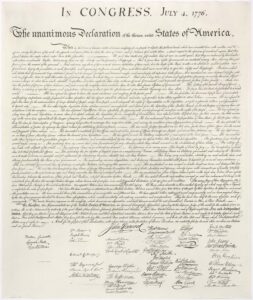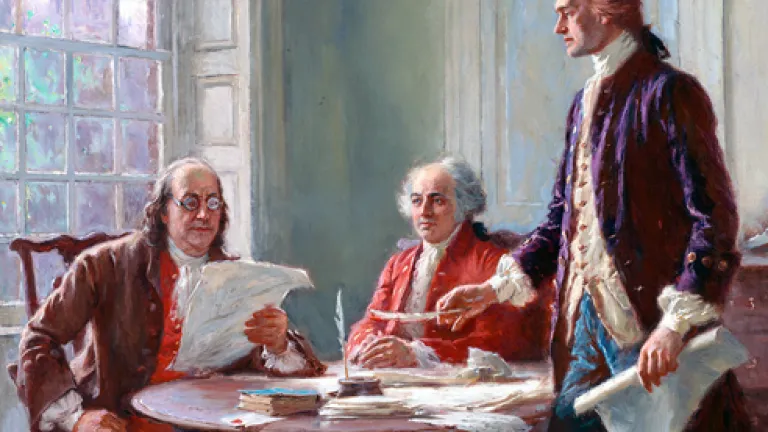False Evidence Explained Simply
False evidence is an oxymoron. The proper expression is the false appearance of evidence. It may come up under different names, such as fabricated evidence, planted evidence, pretend evidence, or under its most familiar name: perjury.
This special aspect of the law is unique, not only do penal sanctions preclude introducing it, but it has its own national holiday. We celebrate its eradication with hotdogs and fireworks. Because it is written in the Declaration of Independence.
For depriving us in many cases, of the benefits of Trial by Jury:
For transporting us beyond Seas to be tried for pretended offences
“All perjured relevant testimony is at war with justice” (In re Michael, 326 U.S. 224, 227 (1945)). “Those who wrote our constitutions knew from history and experience that it was necessary to protect against unfounded criminal charges brought to eliminate enemies”, yet when they form an axis with “the corrupt or overzealous prosecutor” the “inestimable safeguard” provided “an accused with the right to be tried by a jury of his peers” (Duncan v. Louisiana, 391 U.S. 145, 156 (1968))—the “jury being the constitutional tribunal provided for trying facts in courts of law” (Berry v. United States, 312 U.S. 450, 453 (1941))—becomes a casualty of war.
“[T]he Fourteenth Amendment cannot tolerate a state criminal conviction obtained by the knowing use of false evidence.… There can be no retreat from that principle here.” (Miller v. Pate, 386 U.S. 1, 7 (1967))
At its Core, False Evidence is Structural Error (Prejudice Standard)
False evidence is structural error. The Supreme Court requires a “strict standard of materiality” (United States v. Agurs, 427 U.S. 97, 103-104 (1976))
The Supreme “Court has consistently held that a conviction obtained by the knowing use of perjured testimony is fundamentally unfair” (Agurs at 103) and “an error has been deemed structural if the error always results in fundamental unfairness.” (Weaver v. Massachusetts, 137 S.Ct. 1899, 1908 (2017)) Which “means only that the government is not entitled to deprive the defendant of a new trial by showing that the error was ‘harmless beyond a reasonable doubt.’” (Id., at 1910)
Thus consistent with what has been “established that a conviction obtained through use of false evidence, known to be such by representatives of the State, must fall under the Fourteenth Amendment,” (Napue v. Illinois, 360 U.S. 264, 269 (1959))
Normal Error Applies the Chapman Prejudice Standard
Weaver was referencing the prejudice standard from Chapman v. California, 386 U.S. 18, 24 (1967) (“requiring the beneficiary of a constitutional error to prove beyond a reasonable doubt that the error complained of did not contribute to the verdict obtained.” Such that “the court must be able to declare a belief that it was harmless beyond a reasonable doubt.”)
Chapman Cannot Apply to False Evidence
On Feb. 20, 1967, Chapman’s permitting “the beneficiary of a constitutional error” did not include false testimony.
Just one week earlier, on Feb. 13, 1967, the Court in Miller v. Pate 386 U.S. 1, 6 (1967), held that “[t]he prosecution deliberately misrepresented the truth.” — declaring there shall be “no retreat from” “the knowing use of false evidence.” “There has been no deviation from that established principle.” (Id., at 7)
A week later “retreat” and “deviation” were not intended in Chapman, acknowledging: “our prior cases have indicated that there are some constitutional rights so basic to a fair trial that their infraction can never be treated as harmless error,(fn.8)” (id. at 23.)
At fn.8: “See, e. g., Payne v. Arkansas, 356 U. S. 560 (coerced confession); Gideon v. Wainwright, 372 U. S. 335 (right to counsel); Tumey v. Ohio, 273 U. S. 510 (impartial judge).”
Prohibiting coerced confessions was born from Brown v. Mississippi, (1936) 297 U.S. 278, 286:
“The State may not deny to the accused the aid of counsel. Powell v. Alabama, 287 U.S. 45. Nor may a State, through the action of its officers, contrive a conviction through the pretense of a trial which in truth is “but used as a means of depriving a defendant of liberty through a deliberate deception of court and jury by the presentation of testimony known to be perjured.” Mooney v. Holohan, 294 U.S. 103, 112. And the trial equally is a mere pretense where the state authorities have contrived a conviction resting solely upon confessions obtained by violence.”
So why not directly announce false evidence as an exclusion in Chapman? Because Miller just had.
False Evidence Proves Innocence de Jure (by law)
“[W]e explicitly hold that the Due Process Clause protects the accused against conviction except upon proof beyond a reasonable doubt of every fact necessary to constitute the crime with which he is charged.” (In re Winship, 397 U.S. 358, 364 (1970), emphasis added.) The “presumption of innocence ‘lies at the foundation of our criminal law.’” (Nelson v. Colorado, 137 S.Ct. 1249, 1256 (2017)) “Once a defendant has been afforded a fair trial and convicted of the offense for which he was charged, the presumption of innocence disappears.” (Herrera v. Collins, 506 U.S. 390, 399 (1993), italics added.) Thus, because the Supreme “Court has consistently held that a conviction obtained by the knowing use of perjured testimony is fundamentally unfair” (United States v. Agurs, 427 U.S. 97, 103 (1976)) then ipso facto, “the presumption of innocence [re]appears.”
An event that is “fundamentally unfair” fails to produce “the kind of fair trial which is this country’s constitutional goal.” (Pointer v. Texas, 380 U.S. 400, 405 (1965))
It Also Proves Innocence de Facto (in fact)
The federal innocence test requires that our “reasonable jur[y] would… conscientiously obey the instructions… requiring proof beyond a reasonable doubt.” (Schlup v. Delo, 513 U.S. 298, 329 (1995)) Here “more likely than not any reasonable juror would have reasonable doubt” (House v. Warden, 547 U.S. 518, 538 (2006)) because no reasonable juror finds perjury establishes “the truth of the charge” and therefore is “entitled to an acquittal” (Cal. Pen. Code, §1096).
Because in our system the “analysis must incorporate the understanding that proof beyond a reasonable doubt marks the legal boundary between guilt and innocence.” (Schlup at 328; see Cal. Evid. Code, §413)
By definition, perjury cannot be a “fact [a]s an element of an offense” (Jones v. United States, 526 U.S. 227, 232 (1999))
Its Presence in the Record Establishes the Basis for Relief
Recognizing that structural error is present under Weaver and Agurs is objective and easy. Fed. R. Evid. 402 (“Irrelevant evidence is not admissible.”) Cal. Evid. Code, §350 (“No evidence is admissible except relevant evidence.”) If it was admitted into evidence, it was relevant to the government because “the Assistant State’s Attorney himself thought it important to establish before the jury” (Napue at 270).
“‘A lie is a lie… if it is in any way relevant to the case, the district attorney has the responsibility and duty to correct what he knows to be false and elicit the truth”’ (Napue at 269-70).
The major premise is simple:
Not proving a known lie does not make it true;
it only makes it continue to be concealed.
Falsus in uno, falsus in omnibus.
Those who suborn, do not stop at one.
Continuation is Not Permitted
“The most rudimentary of the access-to-evidence cases impose upon the prosecution a constitutional obligation to report to the defendant and to the trial court whenever government witnesses lie under oath. Napue…” (California v. Trombetta, 467 U.S. 479, 485 (1984))
Ethical prosecutors do not believe ‘a little felony perjury never hurt anyone,’ and those that do believe employing a felony in a courtroom is justifiable, are not going to stop after one. The presumption of government correctness, Bute v. Illinois, 333 U.S. 640, 671-72 (1948), has no place in false evidence cases. “Prosecutors’ dishonest conduct or unwarranted concealment should attract no judicial approbation.” (Banks v. Dretke, 540 U.S. 668, 696 (2004))
“District attorneys are not the arbiters of guilt or innocence.” (People v. Talle, 111 Cal.App.2d 650, 678 (1952))
“And it will tend to preserve the criminal trial, as distinct from the prosecutor’s private deliberations, as the chosen forum for ascertaining the truth about criminal accusations.” (Kyles v. Whitley, 514 U.S. 419, 440 (1995))
“Such false testimony and false evidence corrupts the criminal justice system and makes a mockery out of its constitutional goals and objectives.” (Northern Mariana Islands v. Bowie, 243 F.3d 1109, 1124 (9th Cir. 2001))
“The ends in our system do not justify the means. Our Constitution does not promise every criminal will go to jail, it promises due process of law.” (Id.)
Conclusion
The above employed cases that directly implicate the following rights:
- Jury trial,
- Presumption of innocence,
- Proof beyond a reasonable doubt,
- Confrontation clause,
- Due process of law,
- Establishing innocence,
- Prejudice standard through structural error, and
- Double Jeopardy
“The Double Jeopardy Clause forbids a second trial for the purpose of affording the prosecution another opportunity to supply evidence which it failed to muster in the first proceeding.” (Burks v. United States, 437 U.S. 1, 11 (1978)) Logic dictates that a failure to muster precludes the present conviction from sustaining as well.
There is no such thing as a small felony, nor a harmless felony. There is no discretionary aspect of the law permitting a felony to lift the presumption of innocence. The above arguments are simple and clean. Reduced down to their core after writing the concepts many times. Use these direct and simple arguments in your chosen remedy; “a remedy is the means employed to enforce a right or redress an injury.” (Lewis v. Lewis Clark Marine, Inc., 531 U.S. 438, 445 (2001))

